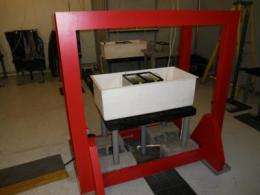Magnetic attraction for fish, crabs?

Super-sized electromagnetic coils are helping explain how aquatic life might be affected by renewable energy devices being considered for placement along America's coastal waters and in the nation's rivers.
Scientists with the Department of Energy's Pacific Northwest National Laboratory are examining whether a variety of fish and invertebrates change their behavior during and after exposure to an electromagnetic field similar to those produced by marine and hydrokinetic power devices that capture energy from ocean waves, tides, currents and rivers. Research began this summer and will continue for two years.
PNNL marine ecologist Jeff Ward will discuss this research Wednesday at Oceans 2010, an ocean engineering conference that runs Monday through Thursday in Seattle. The conference is being hosted by the Marine Technology Society and the Institute of Electrical and Electronic Engineers' Oceanic Engineering Society.
"The ocean's natural ebb and flow can be an abundant, constant energy source," said PNNL oceanographer Andrea Copping, who is the principal investigator on the project out of PNNL's Marine Sciences Laboratory in Sequim, Wash. "But before we can place power devices in the water, we need to know how they might impact the marine environment."
Energy companies and utilities are looking at using several different technologies to harness energy from oceans and rivers. Marine power could come from devices that move with rolling waves on the ocean's surface or from underwater turbines that spin with the tides and currents. And hydrokinetic devices would be similar to marine power devices, but generate power from free-flowing water in rivers and streams. Whatever the design, each device generates electricity that travels through cables that connect the device with a land power line. Researchers want to know how the devices and their cables affect marine life.
Electrical magnetism
This research project is using two specially designed coils at PNNL's Marine Sciences Laboratory. The coils, called Helmholtz coils, each consist of about 200 pounds of copper wiring wrapped into a window frame-like outline that's roughly five feet by five feet. The wiring carries electricity at the flip of a switch. Like any electricity, this creates an electromagnetic field that naturally attracts magnetic materials like iron. The field around the electrical coil can create between 0.1 and 3 milliTeslas of magnetic flux. Three milliTeslas is about three-tenths the magnetic flux of a typical small bar magnet. Previous research into how electromagnetic fields affect marine animals has been in the 3 to 5 milliTesla range.
Researchers want to know if the electromagnetic field will also affect marine and estuarine animal behavior, including migration, finding food and avoiding predators. Several aquatic animals - such as sharks, skates, salmon, sea turtles and lobsters - may use the Earth's natural magnetic fields like a compass to navigate and detect their prey.
To test the field's potential effects, aquarium tanks filled with marine species are being placed near the two coils. Then researchers will activate the electromagnetic field - at various strengths and time periods - to see if the animals' actions change.
For example, researchers will observe whether the electromagnetic field interferes with the ability of juvenile Coho salmon to recognize and avoid predators. Young salmon normally stop swimming, go low and stay still when they detect a predator. Also, the scientists will examine whether the typically fast, flicking movements of Dungeness crab antennules - the small antennae next to crabs' eyes that help them detect odors - change when exposed to the electromagnetic field. And researchers will document whether the animals are attracted or repelled by the fields.
"We really don't know if the animals will be affected or not," Ward said. "There's surprisingly little comprehensive research to say for sure."
New frontiers
There have been some limited studies in this area, but most have been conducted outside the United States and involved animals that aren't common in U.S. waters. Ward noted this project will help develop a broader body of information from which scientists, marine power developers and the regulatory agencies that permit the power devices can draw to determine how proposed devices could affect certain marine life at a given site.
If animals demonstrate a noticeable behavior change in the controlled environment of laboratory tests, PNNL researchers may conduct a field study with test animals placed near pilot marine power devices such as the one Snohomish County PUD has proposed for Admiralty Inlet in Washington state's Puget Sound.
As part of the project, scientists at Oak Ridge National Laboratory are also examining how electromagnetic fields created by hydrokinetic devices, which generate power from free-flowing water in rivers and streams, might affect freshwater animals. And researchers from Northwest National Marine Renewable Energy Center at Oregon State University are also studying the potential electromagnetic effects on crabs.
This study is a component of PNNL's larger research effort to better understand the potential environmental impact of marine and hydrokinetic energy development. PNNL researchers are also examining whether underwater noise from these devices could impact aquatic life, whether underwater animals could be injured by the rotating turbines in tidal power devices and how marine devices could impact the flow patterns of coastal waters.
More information: J. Ward, I. Schultz, D. Woodruff, G. Roesijadi, A. Copping. "Assessing the Effects of Marine and Hydrokinetic Energy Development on Marine and Estuarine Resources." Oceans 2010.
Provided by Pacific Northwest National Laboratory

















